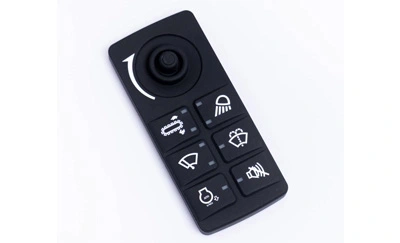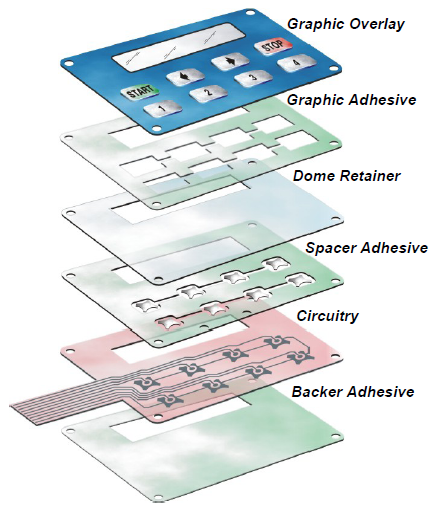Everything About Membrane Switch: A Comprehensive Overview for Beginners
Membrane buttons are important parts in contemporary electronics, using a distinct user interface for individual communication - membrane switch. Their layered building and construction, including overlays and conductive traces, gives performance and durability. Unlike standard mechanical switches, membrane buttons present a streamlined design and adjustable options. Comprehending their vital functions and advantages can transform product layout. The details of their application and design factors to consider necessitate further exploration.
What Is a Membrane layer Switch over?
A membrane switch is a kind of electric button that includes a versatile membrane layer layered over a published motherboard. This design enables for a portable and sleek interface, commonly made use of in various electronic devices. Membrane switches are frequently located in customer devices, medical equipment, and industrial machinery due to their sturdiness and resistance to environmental factors.The building normally consists of numerous layers, such as graphic overlays and sticky support, which offer responsive feedback and safeguard the wiring beneath. The operation of a membrane button is launched when pressure is applied to the surface, finishing an electric circuit.These switches are valued for their flexibility, making it possible for personalized layouts and printed graphics that deal with particular individual interfaces. Their low-profile nature minimizes room demands, making them ideal for applications where traditional switches might not fit. In general, membrane switches offer a visual and useful option for modern-day electronic gadgets.
Trick Elements of Membrane Layer Switches
Membrane layer switches over consist of a number of vital parts that add to their capability and efficiency. The top layer, recognized as the overlay, offers the interface and is often published with graphics or signs. Under the overlay lies a spacer layer, which divides the conductive components and protects against inadvertent activation. The next important part is the visuals layer, which enhances aesthetic appeals and assures the toughness of the design.Conductive traces, typically made from materials like silver or carbon, are published on the circuit layer. When stress is put on the overlay, these traces enter into call, finishing the circuit. In addition, a support layer uses structural assistance and can be made from products such as polyester or polycarbonate. With each other, these components produce a reputable, straightforward interface ideal for different applications, from family appliances to commercial devices. Comprehending these elements is crucial for any person thinking about membrane layer button technology.
How Membrane Layer Switches Over Job
Understanding exactly how membrane layer switches function is necessary for valuing their extensive use in numerous gadgets. A membrane layer switch operates through a series of layers, including a visuals overlay, spacer, and a circuit layer. When pressure is applied to the overlay, it presses the spacer layer, permitting the circuit layer to make get in touch with and complete an electrical circuit. This activity sends out a signal to the tool, triggering a feedback, such as switching on a light or turning on a function.Membrane switches over can be made with various features, including tactile responses, backlighting, and customized graphics, enhancing individual interaction. Their building and construction permits a covered style, securing the interior components from dust, wetness, and impurities. This longevity makes them suitable for varied applications, from customer electronics to industrial tools. Generally, the simplicity and efficiency of membrane layer changes contribute to their appeal in modern-day technology.
Benefits of Membrane Layer Switches Over Over Mechanical Buttons
While mechanical switches have actually long been a staple in lots of devices, membrane layer switches deal distinctive benefits that make them progressively appealing. One significant benefit is their slim profile, enabling even more portable layouts and greater versatility in product growth. Furthermore, membrane layer switches over function an uniform surface area, which boosts visual charm and simplifies cleansing, making them suitable for settings where hygiene is critical.Another advantage is their resistance to dirt and moisture. Unlike mechanical switches, which can be jeopardized by environmental aspects, membrane layer switches give a closed interface that safeguards versus contaminants - membrane switch. Furthermore, membrane layer buttons generally have a longer lifespan because of less relocating parts, causing enhanced sturdiness and reliability.Cost-effectiveness is additionally a notable advantage, as membrane switches can be created wholesale with lower production expenses. These elements incorporate to position membrane switches as a functional choice to typical mechanical choices in various applications
Usual Applications of Membrane Layer Switches Over
Membrane buttons are widely used in numerous fields, specifically in customer electronic devices and industrial control panels. In customer tools, they supply a streamlined, user-friendly interface, while in commercial setups, they boost resilience and performance. Recognizing these applications highlights the versatility and practicality of membrane layer buttons in modern innovation.
Customer Electronic Devices Gadgets
As customer electronic devices proceed to progress, membrane switches have come to be a popular selection for a range of devices due to their adaptability and streamlined design. These buttons are generally located in mobile phones, tablets, and push-button controls, where space is minimal and looks issue. Their reduced profile and customizable styles permit manufacturers to create easy to use user interfaces that enhance the general individual experience. Furthermore, membrane layer buttons are commonly made use of in devices such as microwaves and coffee makers, supplying instinctive control choices while withstanding wetness and dirt. The toughness and integrity of membrane switches over make them appropriate for daily consumer items, guaranteeing longevity and regular performance. Overall, their combination in customer electronic devices reflects a blend of capability and modern design.
Industrial Control Panels
The applications of membrane switches over prolong beyond consumer electronics, finding considerable usage in industrial control panels. These switches are preferred for their durability and resistance to severe atmospheres, making them optimal for producing and procedure control setups. They give a reliable user interface for operators to manage machinery, screen procedures, and readjust setups. Membrane switches can be tailored to suit details functional needs, incorporating attributes like backlighting and responsive comments, boosting user experience. Their low-profile style enables combination into numerous equipment, while their capacity to hold up against spills, dirt, and severe temperature levels assurances long life. Generally, membrane switches add to efficient and risk-free operation in industrial applications, showing their convenience and effectiveness popular settings.
Factors To Consider for Designing Membrane Changes
When making membrane layer buttons, selecting the best materials is important to assure resilience and performance. Furthermore, recognizing layer arrangement strategies can greatly affect the switch's performance and user experience. These considerations play an essential role in creating efficient and reputable membrane layer button styles.
Material Selection Value
Product option plays an important role in the design and functionality of membrane layer buttons. The selected materials directly affect the button's longevity, responsive view it action, and general aesthetic. Key factors to consider consist of the substrate, which should provide architectural honesty while enabling flexibility, and the graphic overlay, which requires to be resistant to wear and ecological aspects. Conductive materials should assure trustworthy electrical performance, while adhesives have to use strong bonding without jeopardizing the switch's procedure. Furthermore, compatibility with manufacturing procedures and end-user atmospheres is vital; products need to endure differing temperature levels, humidity degrees, and chemical exposure. Inevitably, suitable product choice not only improves the membrane button's performance however also adds to its longevity and customer complete satisfaction, making it a crucial facet of the design procedure.

Layer Arrangement Methods

Often Asked Questions
For How Long Do Membrane Switches Over Generally Last?
Membrane layer buttons typically have a life-span of 1 to 5 million cycles, depending upon use and environmental conditions. Variables such as design high quality and operating regularity significantly affect their durability and general efficiency long life.

Can Membrane Switches Over Be Personalized for Certain Designs?
Membrane buttons can undoubtedly be personalized to accommodate details styles, enabling for diverse forms, colors, and functionalities. This convenience allows producers to customize these buttons to meet one-of-a-kind visual and operational needs efficiently.
What Materials Are Utilized in Membrane Switch Over Building?
Membrane switches are typically built making use of materials such as polyester, polycarbonate, and glue layers. These materials supply resistance, toughness, and flexibility to ecological elements, making certain the buttons operate efficiently in different applications and problems.
Are Membrane Switches Waterproof or Resistant to Moisture?
Membrane switches can be created to be moisture-resistant, making use of specialized products and layers. However, their waterproof capabilities depend upon building high quality and certain applications, making it essential to assess requirements for optimal performance in different atmospheres.
How Are Membrane Switches Fixed if Harmed?
Repairing damaged membrane switches over commonly entails replacing the affected layer or circuit. Specialists may additionally use conductive sticky or utilize specialized repair service sets, ensuring functionality is recovered without total replacement of the whole button assembly. Unlike traditional mechanical buttons, membrane layer switches offer a smooth design and personalized alternatives. A membrane button is a kind of electrical button that consists of an adaptable membrane layer layered over a printed circuit board. The procedure of a membrane button is started when pressure is used to the surface, finishing an electrical circuit.These buttons are valued for their flexibility, making it possible for personalized layouts and printed graphics that provide to specific you could try this out individual interfaces. While mechanical buttons have actually long been a staple in lots of tools, membrane switches over offer distinctive advantages Go Here that make them increasingly appealing. Membrane layer buttons normally have a longer lifespan due to less moving parts, resulting in boosted toughness and reliability.Cost-effectiveness is also a significant benefit, as membrane buttons can be produced in bulk with reduced manufacturing expenses.